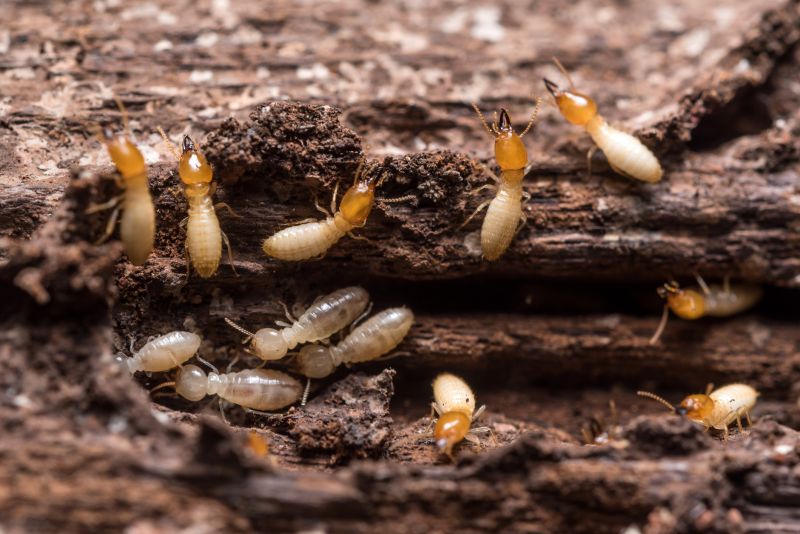Expert Picks For Reliable Termite Prevention Tools
Discover the most trusted termite control products favored by professionals for safeguarding homes and structures.
 Effective termite control products are essential for maintaining the integrity of a property and preventing costly damage caused by these wood-destroying insects. There are numerous options available, ranging from liquid treatments to bait systems, each suited to different levels of infestation and property types. Understanding the various product categories can help homeowners and professionals select the most appropriate solution for their specific needs.
Effective termite control products are essential for maintaining the integrity of a property and preventing costly damage caused by these wood-destroying insects. There are numerous options available, ranging from liquid treatments to bait systems, each suited to different levels of infestation and property types. Understanding the various product categories can help homeowners and professionals select the most appropriate solution for their specific needs.
Top Overall Option
Liquid Soil Treatment System
A comprehensive liquid soil treatment system provides a versatile option for creating a chemical barrier around a property’s foundation. When applied correctly, it can help deter termites from entering structures by establishing a continuous barrier in the soil. This method is widely used both by professionals and experienced DIYers, offering a reliable approach to termite prevention and control.
Types of Products For Termite Controls
Liquid Soil Barriers
Chemical solutions applied to soil to form a barrier that prevents termite entry.
Baiting Stations
Stations placed around the property that attract termites and deliver bait to control colonies.
Foam Treatments
Foam products used to target localized infestations or treat wood directly.
Physical Barriers
Material barriers installed during construction to block termite access.
Termite Shields
Metal or plastic shields installed on foundations to prevent termite intrusion.
Wood Treatments
Chemical sprays or coatings applied directly to wood to protect against termite damage.
Liquid Concentrates
Highly concentrated liquids for mixing and application in soil or wood treatments.
Drill and Treat Products
Products designed for injection into infested wood or soil via drilled holes.
Repellent Sprays
Sprays that repel termites away from treated areas, often used as a preventative measure.
Non-repellent Soil Treatments
Chemicals that are not detected by termites, allowing them to contact and carry the poison back to colonies.
Popular Choices
Widely used for creating a protective chemical barrier around structures.
Effective for ongoing monitoring and colony elimination around properties.
Ideal for spot treatments and localized infestations in wood or wall voids.
Commonly installed during new construction to prevent termite entry.
Often used in conjunction with other treatments to block access points.
Direct application to wood structures to reduce vulnerability.
Concentrated solutions suitable for mixing and targeted application.
Used for precise injection into infested wood or soil.
Applied as a preventive measure around vulnerable areas.
Chemicals that are undetectable to termites, allowing for effective colony control.
Liquid termiticides are commonly used for soil treatment around a property’s foundation, creating a chemical barrier that deters termites from entering. These products are often applied by professionals but are also available for DIY applications, provided proper safety precautions are followed. Baiting systems involve placing stations around the property that attract termites, which then carry poison back to their colonies. These systems are designed to reduce termite populations over time and can be an effective part of integrated pest management.
Another popular option includes foam treatments, which are used for localized infestations or to treat wood structures directly. These products are injected into termite galleries or applied to infested wood to eliminate colonies. Additionally, termite shields and physical barriers can be installed during construction to prevent termites from gaining access to the structure. Combining these physical barriers with chemical treatments enhances overall protection.
Choosing the right product depends on several factors, including the extent of the infestation, the type of structure, and personal preferences for chemical use. Proper application and ongoing monitoring are crucial for effective termite management. Consulting with pest control professionals can provide tailored solutions, but understanding product options empowers homeowners to make informed decisions about protecting their property.
Key Buying Considerations
- Extent of infestation and whether professional assessment is recommended.
- Type of structure and its susceptibility to termite entry points.
- Application method preferred, such as DIY or professional service.
- Chemical versus physical control options based on preferences and safety.
- Long-term protection strategies and whether ongoing monitoring is desired.
- Compatibility of product with existing pest control plans.
- Ease of application and required safety precautions during use.
- Coverage area of the product to ensure sufficient treatment.
- Potential impact on surrounding landscaping or structures.
- Availability of customer support or professional guidance.
- Product shelf life and storage requirements.
- Cost considerations relative to the size of the property and infestation severity.
- Local regulations regarding chemical use and treatment methods.
- Compatibility with other pest control products or treatments.
